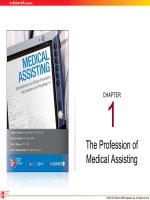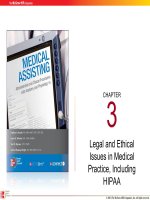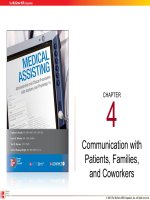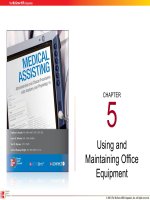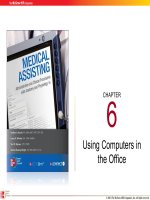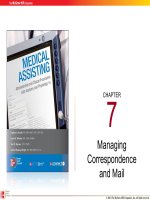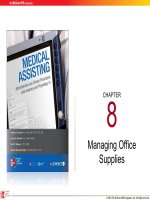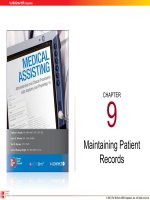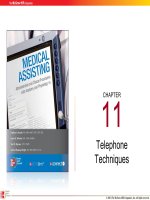Lecture Medical assisting: Administrative and clinical procedures with anatomy and physiology (4e) – Chapter 4
Bạn đang xem bản rút gọn của tài liệu. Xem và tải ngay bản đầy đủ của tài liệu tại đây (1.7 MB, 67 trang )
CHAPTER
4
Communication with
Patients, Families,
and Coworkers
© 2011 T he McGraw -Hill Com panie s, Inc. A ll rights reserv ed.
4-2
Learning Outcomes
4.1 Identify elements of the
communication circle.
4.2 Understand and define the
developmental stages of the life cycle.
4.3 Give examples of positive and
negative communication.
© 2011 T he McGraw -Hill Com panie s, Inc. A ll rights reserv ed.
4-3
Learning Outcomes (cont.)
4.4 List ways to improve listening and
interpersonal skills.
4.5 Explain the difference between
assertiveness and aggressiveness.
4.6 Give examples of effective
communication strategies with patients
in special circumstances.
© 2011 T he McGraw -Hill Com panie s, Inc. A ll rights reserv ed.
4-4
Learning Outcomes (cont.)
4.7 Discuss ways to establish positive
communication with coworkers and
management.
4.8 Describe how the office policy and
procedures manual is used as a
communication tool in the medical
office.
© 2011 T he McGraw -Hill Com panie s, Inc. A ll rights reserv ed.
4-5
Learning Outcomes (cont.)
4.9 Describe community resources and
how they enhance the services
provided by your office.
4.10 Explain how stress relates to
communication and identify strategies
to reduce stress.
© 2011 T he McGraw -Hill Com panie s, Inc. A ll rights reserv ed.
4-6
Introduction
• Medical assistants
must
– Recognize human
behaviors
– Communicate
effectively, with
professionalism and
diplomacy
– Recognize obstacles
that affect therapeutic
communication
© 2011 T he McGraw -Hill Com panie s, Inc. A ll rights reserv ed.
4-7
Communicating with Patients and Families
• You are the key communicator between the
physician and patient
• Your interaction sets the tone for the office visit
• Developing strong communication skills is just
as important as mastering administrative and
clinical skills
Communication will influence how comfortable the
patient feels in your practice.
© 2011 T he McGraw -Hill Com panie s, Inc. A ll rights reserv ed.
4-8
Communicating with Patients and Families
(cont.)
• Customer service
– Most important part of
communication
Pati
ent s
a re
#1!
– Two points fundamental to customer service
• The patient comes first
• Patient needs are satisfied
© 2011 T he McGraw -Hill Com panie s, Inc. A ll rights reserv ed.
4-9
Communicating with Patients and Families
(cont.)
• Examples of customer service
– Telephone techniques
– Writing or responding to telephone
messages
– Explaining procedures to patients
– Assisting with billing issues
– Creating a warm and reassuring
environment
© 2011 T he McGraw -Hill Com panie s, Inc. A ll rights reserv ed.
4-10
Apply Your Knowledge
What are the two key parts of customer
service?
ANSWER: The two fundamental parts of customer service
are that the patient comes first and you must satisfy
patient needs.
© 2011 T he McGraw -Hill Com panie s, Inc. A ll rights reserv ed.
4-11
The Communication Circle
The communication
circle involves an
exchange of
messages through
verbal and nonverbal
means.
© 2011 T he McGraw -Hill Com panie s, Inc. A ll rights reserv ed.
4-12
Communication Process
• Patients often believe that health care has become
impersonal due to
– Technological advances
– Managed care organizations
• Maintain a patient-centered approach
© 2011 T he McGraw -Hill Com panie s, Inc. A ll rights reserv ed.
4-13
Apply Your Knowledge
What are the three elements of the communication
circle?
ANSWER: The three elements of the
communication circle are the message, source,
and receiver.
RIGHT!
© 2011 T he McGraw -Hill Com panie s, Inc. A ll rights reserv ed.
4-14
Human Behavior: Stages of the Life Cycle
• Understanding growth
and development
enhances
communication skills
– Physical development
– Psychological and
emotional growth
• Guidelines for
communication based
on developmental
stage
–
–
–
–
–
–
Infant
Toddler
Preschooler
School age
Adolescence
Young, middle, old
adult
© 2011 T he McGraw -Hill Com panie s, Inc. A ll rights reserv ed.
4-15
Maslow’s Hierarchy of Human Needs
Self-Actualization
Esteem Needs
Love/Belonging Needs
Safety Needs
Physiological Needs
Deficiency (Basic) Needs
© 2011 T he McGraw -Hill Com panie s, Inc. A ll rights reserv ed.
4-16
Apply Your Knowledge
You can communicate with all people in the same way. Is
this statement true or false, and why?
ANSWER: The statement is false. Not all people are at the same
place on Maslow’s hierarchy of human needs. To communicate
effectively with a person, you need to understand what he or she
is deficient in. For example, you would use different
communication styles when talking to a homeless person who
may have psychological and safety needs than when talking to an
elderly person who is lonely and depressed due to the recent loss
of his or her spouse.
© 2011 T he McGraw -Hill Com panie s, Inc. A ll rights reserv ed.
4-17
Types of Communication
• Positive or negative
• Verbal or non-verbal
• Written (Chapter 7)
© 2011 T he McGraw -Hill Com panie s, Inc. A ll rights reserv ed.
4-18
Positive Verbal Communication
• Communication
promotes
the patient’s comfort
and well-being
– Set the stage for
positive
communication
– Encourage patients
to ask questions
– Speak slowly and
clearly
© 2011 T he McGraw -Hill Com panie s, Inc. A ll rights reserv ed.
4-19
Negative Verbal Communication
Curb negative communication habits
Mumbling
Speaking brusquely
Avoiding eye contact
Interrupting patients as they speak
Rushing explanations
Forgetting common courtesies
Showing boredom
Treating the patient impersonally
© 2011 T he McGraw -Hill Com panie s, Inc. A ll rights reserv ed.
4-20
Non-Verbal Communication
• Facial expression
• Eye contact
• Posture
– Open
– Closed
• Touch
• Personal space
In many instances, people’s body language conveys their true
feelings, even when their words may say otherwise.
© 2011 T he McGraw -Hill Com panie s, Inc. A ll rights reserv ed.
4-21
YEA!
Apply Your Knowledge
Mr. Garcia comes to the desk to check in and asks if he will be seen on
time. The receptionist continues with her paperwork, points to the signin sheet, and tells Mr. Garcia: “Just sign in. The doctor will be with you
when he can.” Explain why this is an example of negative
communication.
ANSWER: This is an example of negative communication because the
clerk
• Did not stop what he or she was doing – was not friendly or attentive
• Did not greet Mr. Garcia or make eye contact with him
• Did not give a satisfactory answer to Mr. Garcia’s question
• Did not make sure Mr. Garcia understood when he would be seen
© 2011 T he McGraw -Hill Com panie s, Inc. A ll rights reserv ed.
4-22
Improving Communication Skills
• Listening skills
– Passive listening
– Active listening
• Improve listening skills
– Prepare to listen
– Relax and listen attentively
– Maintain eye contact
– Maintain personal space
– Think before you
respond
– Provide feedback
© 2011 T he McGraw -Hill Com panie s, Inc. A ll rights reserv ed.
4-23
Improving Communication Skills (cont.)
• Interpersonal skills
– Warmth and
friendliness
– Empathy
– Respect
– Genuineness
– Openness
– Consideration and sensitivity
© 2011 T he McGraw -Hill Com panie s, Inc. A ll rights reserv ed.
4-24
Therapeutic Communication
• The ability to communicate with patients
– In terms they can understand
– So they feel at ease and comfortable
• The ability to communicate with other members of the
health-care team
– Technical terms
– Appropriate to the health-care setting
© 2011 T he McGraw -Hill Com panie s, Inc. A ll rights reserv ed.
4-25
Therapeutic Communication (cont.)
• Involves
Silence
Accepting
Encouraging
communication
Mirroring
Reflecting
Focusing
Giving recognition
Offering self
Giving a broad opening
Exploring
Offering general leads
Clarifying
Making observations
Summarizing
© 2011 T he McGraw -Hill Com panie s, Inc. A ll rights reserv ed.
